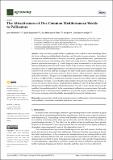Por favor, use este identificador para citar o enlazar a este item:
http://hdl.handle.net/10261/268130COMPARTIR / EXPORTAR:
 SHARE SHARE
 CORE
BASE CORE
BASE
|
|
| Visualizar otros formatos: MARC | Dublin Core | RDF | ORE | MODS | METS | DIDL | DATACITE | |

| Título: | The Attractiveness of Five Common Mediterranean Weeds to Pollinators |
Autor: | Morrison, Jane; Izquierdo, Jordi; Hernández Plaza, María Eva CSIC ORCID ; González-Andújar, José Luis CSIC ORCID | Palabras clave: | Agroecosystems Biodiversity Ecosystem services Field margins Environmental management Pollinator conservation Sustainable agriculture Weed science |
Fecha de publicación: | 28-jun-2021 | Editor: | Multidisciplinary Digital Publishing Institute | Citación: | Agronomy 11(7): 1314 (2021) | Resumen: | Concerns about a global decline in pollinators have called for more knowledge about the factors influencing wild pollinator abundance and diversity in agroecosystems. Agricultural intensification has been identified as the main cause of this “global pollinator crisis”, particularly due to reductions in natural areas holding critical floral and nesting resources. Maintaining native wild plants in agricultural landscapes (e.g., in field margins) is often recommended as a cost-effective and efficient method for pollinator conservation. In this study, the role of common wild flowers, often considered weeds, in supporting pollinators in a Mediterranean agroecosystem was investigated. This work involved a two-year field trial to compare five native weed species common in Mediterranean cereal agroecosystems: Convolvulus arvensis L., Daucus carota L., Malva sylvestris L., Papaver rhoeas L., and Sonchus oleraceus L. The goal was to compare the attractiveness of these species, and a mixture of all five, to different flower-visiting insect groups in order to assess their value in supporting wild pollinators. Overall, D. carota had the highest number of insect visits, followed by P. rhoeas. C. arvensis, M. sylvestris, and S. oleraceus, which had lower numbers of visits. On the basis of their overall attractiveness to pollinators and low risk for invasiveness, D. carota, P. rhoeas, and M. sylvestris are the most likely to contribute positively to the conservation of pollinators in agroecosystems. Our results also suggest that it is advantageous for wild flowers sown for the purpose of pollinator conservation to be grown in clumps, rather than highly intermingled, for improved visitation rates. | Versión del editor: | http://dx.doi.org/10.3390/agronomy11071314 | URI: | http://hdl.handle.net/10261/268130 | DOI: | 10.3390/agronomy11071314 | Identificadores: | doi: 10.3390/agronomy11071314 e-issn: 2073-4395 |
| Aparece en las colecciones: | (IAS) Artículos |
Ficheros en este ítem:
| Fichero | Descripción | Tamaño | Formato | |
|---|---|---|---|---|
| Five_Common_Mediterranean_Weeds.pdf | 1,19 MB | Adobe PDF |  Visualizar/Abrir |
CORE Recommender
Page view(s)
63
checked on 29-abr-2024
Download(s)
52
checked on 29-abr-2024
Google ScholarTM
Check
Altmetric
Altmetric
Este item está licenciado bajo una Licencia Creative Commons



